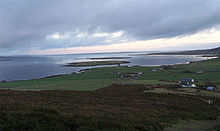Cuween Hill Cairn
The Cuween Hill Cairn is located on Cuween Hill, 800 m south of the village of Finstown , on the Bay of Firth on Mainland an island of Orkney in Scotland . The Passage Tomb of Maeshowe type is at the end of a path, with views of the Bay, climbs up on the eastern slope of the hill.
Surname
The name Cuween is derived from the Old Norse "Kua-eng" ( German cattle pasture ). The current spelling is relatively new. Like other Orkney place names, the hill was spelled "Kewing" in the early 20th century. In popular opinion, Cuween, like other megalithic sites, was the home of trolls or fairies . As a result, the local name for the cairn is "Fairy Knowe" ( German Feenhügel ).
description
Although smaller than Maes Howe , Cuween Cairn is also the result of impressive prehistoric architecture. Access to the interior is through a low, narrow passage that is less than a meter high and 5.5 meters long. The passage leads into a rectangular chamber with four side chambers (one on each side). One of them is a double chamber. Typical Maes Howe type systems have only three secondary chambers. Vinquoy on Eday also has four, while Isbister Cairn (Tomb of the Eagles) on South Ronaldsay has five and Quoyness on Sanday has six, and South Cairn on Papa Westray even has twelve. The four entrances to the side chambers are slightly above the level of the floor of the main chamber. The main chamber built from layers of stone slabs is spacious. Today the main and secondary chambers are over two meters high. The original roof of the main chamber was damaged when entering the cairn in the 19th century. The current roof is a modern construction. The original was probably significantly higher. The probably 3000 BC The cairn was built in 1901 by M. M. Charleson.
Finds
The remains of at least eight people, mostly the skulls, and the bones of cattle and birds have been found inside. The small number indicates that the chamber was cleared at least once during its use. The excavators found the Cuween Cairn, like other Orcadian graves, carefully locked. This would indicate that the facility had either gone out of use, or that it was always sealed between uses at intervals of several years.
The dog skull
The most interesting discovery, aside from human bones, was the discovery of 24 dog skulls. This led to the idea that the dog was the totem animal of the users, much like the sea eagle is characteristic of the Isbister Cairn (Tomb of the Eagles) on South Ronaldsay .
The settlement
The settlement of Stonehall is just below Cuween Hill. Stonehall was a Neolithic village older than the Knap of Howar on Papa Westray. Given the proximity between the cairn and the settlement, and the fact that the two are contemporary, it is reasonable to assume that the settlers of Stonehall were also responsible for the construction and use of the cairn.
literature
- R. Bradley: Incised motifs in the passage-graves at Quoyness and Cuween, Orkney , Antiquity, Vol. 72, 276, 1998, pp. 387-390
- Anna Ritchie: Orkney and Shetland (= Exploring Scotland's Heritage. ). Published for Royal Commission on the Ancient and Historical Monuments of Scotland by HMSO, Edinburgh 1985, ISBN 0-11-492458-9 .
Web links
- Description (engl. + Pictures)
- Basic plan
- Stonehall settlement engl.
- Entry on Cuween Hill Cairn in Canmore, Historic Environment Scotland database
Coordinates: 58 ° 59 ′ 50.6 " N , 3 ° 6 ′ 29.8" W.


